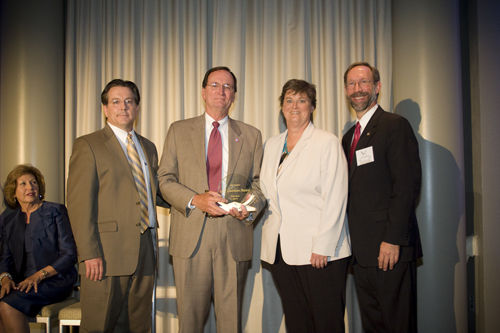At-large judge seats unfair, lawsuit says
February 13, 2014Volunteers needed for bayou cleanup
February 13, 2014A Houma resident on Monday will claim leadership of the state’s top position on coastal issues.
Jerome Zeringue, who spent a decade as director of the Terrebonne Levee and Conservation District, will replace Garret Graves as chair of the Costal Protection and Restoration Authority and as the governor’s top coastal advisor, Gov. Bobby Jindal announced last week. Graves has resigned from his position, effective Feb. 17.
“It’s obviously huge shoes to fill,” said Zeringue, CPRA’s executive director for the past three years.
The CPRA board reflects the state’s position relative to coastal protection, conservation, enhancement and restoration policies and oversees the Coastal Protection and Restoration Trust Fund. Further, the board formulates coastal master plans – the last, a $50 billion, 50-year plan approved in 2012 – and enforces compliance with its priorities.
Created in the aftermath of hurricanes Katrina and Rita, the authority was intended to homogenize management of coastal issues, which when separated sometimes clashed. Prior to CPRA, the Department of Natural Resources and Department of Transportation and Development led restoration and protection, respectively.
“It’s amazing how far we’ve come,” the 51-year-old appointee said, crediting Graves above anyone else for an agency widely lauded as a success. “You look at the capacity in terms of output. Previously, the Department of Natural Resources was using trust fund dollars, which generated around $35 million a year to do projects. … We have constructed over $1 billion. We have done more in terms of the last five years than what the previous agencies had done for decades.”
Louisiana is expecting a windfall of money stemming from fines levied against BP and other parties deemed responsible for the Deepwater Horizon disaster in 2010. Ultimately, the state’s share could reach billions of dollars, and the Legislature has already dedicated these funds to the master plan.
“Now with the master plan and the funding, we believe we will get to the point where we can be building more wetlands than we’re using, but it’s incumbent upon us and it’s critical that we don’t waste this opportunity,” Zeringue said.
Zeringue, frequently referred to as “Zee,” is a “great fit” as incoming CPRA head, Jindal said.
“We need a seamless transition to continue the great progress made over the last six years,” Jindal said. “Zee has been here since day one of my administration and has great respect among parish and levee district leaders and has a long and distinguished history in implementing coastal projects.”
State Rep. Gordon Dove, R-Houma, signed off on Zeringue’s appointment 10 days before the announcement, he said.
“I totally recommended Jerome without hesitating,” Dove said. “(Zeringue) was a very, very close second to Garret, and he was there on a lot of issues, if not all of them. … He’ll agree and disagree with you. I like someone like that. Garret was the same way. But both of them are willing to sit down, discuss an issue on what the people would like, what the fishermen would like and what is scientific and how cost-effective is something.”
Local levee district directors acknowledge Graves’ absence will create a void, particularly because of his experience navigating politics on the federal level and the respect he’s earned statewide. Graves, who worked as a legislative aide to former U.S. Rep Billy Tauzin and for U.S. Senator David Vitter, garnered a reputation as a Congressional whiz kid working the House Appropriations Committee and Senate Committee on Environment and Public Works before leading governor’s office of coastal activities.
But to have in the governor’s ear a child of Thibodaux and resident of Houma, someone familiar with the region’s geography, its predominant issue and the science behind it, is a great asset, they also said. For all the credit Graves rightfully gets for stabilizing the post-Katrina coalescence of restoration and protection efforts, Zeringue was his longstanding No. 2 and did much to further coastal interests, south Louisiana’s levee district leaders point out.
“Having Jerome there is not a bad thing at all. I just felt that with Garret’s experience in Washington and Jerome’s experience in coastal Louisiana, it was just a real good combination,” said South Lafourche Levee District Director Windell Curole. “They worked great together.”
Simone Maloz, executive director of Restore or Retreat, characterized Graves and Zeringue as “wildly different but so complementary.” Zeringue, a former member of ROR’s executive committee, has a knack for breaking tension with a joke, Maloz said.
He also remained upbeat amid repeated rejections and roadblocks relating to Morganza during his days advocating for the project from the local level.
Dwayne Bourgeois, executive director of the North Lafourche Levee District,
“I think (Zeringue) a little less intense than Garret, but few people are as intense as Garret,” Bourgeois said, echoing a commonly expressed opinion. “We deal with each other regularly. It’s been exceptionally good for us because of (Zeringue’s) understanding of our environment. … It’s great news for our area.”
Lafourche and Terrebonne parishes are key elements in the state’s ongoing coastal restoration and protection efforts.
In Lafourche are two of the great indicators of land loss, with the economic engine Port Fourchon isolated from the mainland except elevated La. Highway 1 and nearly all land outside the ring levee system gone. North Lafourche is becoming increasingly susceptible to tidal surges as land subsides and regional protection components funnel water through the Barataria Basin, officials say.
Terrebonne has seen a gradual migration of its residents from the parish’s southern reaches and has long led lobbying efforts for the 72-mile-long Morganza to the Gulf, the largest pending public works project in the United States, to wall off their communities from tidal surges.
Aided by the public’s approval of a sales-tax levy and the $100 million bonded from it, plus state support, Terrebonne officials have begun constructing Morganza’s footprint. The project has not been authorized at the federal level, though the House and Senate are expected to tackle that issue during an ongoing conference committee for a Water Resources Development Act bill.
Local officials said Zeringue’s knowledge of Lafourche and Terrebonne’s landscape and deep familiarity with prospective projects would aid locals. That his hometown and livelihood are on the coast has made him intimately familiar with the problems and consequences of doing nothing, he said.
His appointment “helps Morganza, helps Larose to Golden Meadow, helps north Lafourche,” Zeringue said. ‘The coastal area, the experience that I have recognizing the vulnerabilities these coastal communities face, the fact that they are so exposed and vulnerable and if the issues continue the way they are, these coastal communities and economies cannot survive unless we address coastal land loss.”
The Thibodaux native attained a bachelor’s degree in zoology and master’s in fisheries biology, both from LSU. He is a former fisheries biologist at LSU Sea Grant and coastal resources director for the nonprofit Nature Conservancy of Louisiana, where he helped establish the Mandalay National Wildlife Refuge.
Zeringue left the Terrebonne levee district in 2008 to serve in the state’s office on coastal activities when CPRA was coming together. He became the authority’s deputy executive director before ascending to the directorship three years ago.
“There are just a few people in this world that rank up there with Zee,” Graves said. “His integrity is impeccable and his dedication to Louisiana is strong. You can count on Zee doing the right thing 100 percent of the time.”
During Graves’ six-year tenure as coastal chief, he coordinated responses to hurricanes Gustav, Ike and Isaac, the spring flood threat of 2011 and the Gulf of Mexico’s BP Deepwater Horizon disaster.
“I learned that it’s almost impossible to keep up with him,” Zeringue said.
The outgoing head has sparred with the U.S. Army Corps of Engineers regarding protection, the Coast Guard over holding BP accountable for oil cleanup and the South Louisiana Flood Protection Authority-East for its lawsuit against oil and gas companies.
“I couldn’t be prouder with how (Graves) carried the ball with this,” said Reggie Dupre, current TLCD director and a former state senator who was instrumental in reorganizing direction of coastal issues. “(But) I think this will be a very easy transition. The best one got the job.”
Might Graves campaign to represent you?
Outgoing CPRA chief Garret Graves has thus far not committed to his next move, saying he will spend time with his family while considering his options – which seem to include federal lawmaking.
The departing CPRA chair told the Greater Baton Rouge Business Report last week he had not ruled out a campaign for the 6th Congressional District, which encompasses northern portions of Lafourche and Terrebonne parishes.
“I have no idea at this point if I will run,” he told the journal. “But I have been approached about it over the past six months and, even more so recently, in the past few weeks.”
Aspiring Senator Bill Cassidy will vacate the seat to battle Sen. Mary Landrieu.
Among the candidates to announce already are state Sen. Dan Claitor, businessman Paul Dietzel II, and tax lawyer Cassie Felder, all Republicans from Baton Rouge, and real estate broker Richard Dean Lieberman, a LaPlace Democrat.
Former Gov. Edwin Edwards has allowed his name to be bandied throughout the district, and his supporters have reportedly polled 6th District voters, but he has not announced an intention to run.









